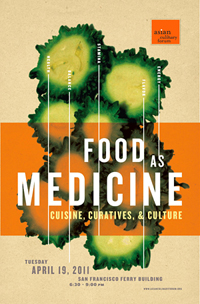 Do you see the universe on your plate? Vinita Chopra Jacinto wants you to.
Do you see the universe on your plate? Vinita Chopra Jacinto wants you to.
The culinary instructor from CCA -- one of four panelists in a moderated discussion hosted by the Asian Culinary Forum on Food as Medicine: Cuisine, Curatives, & Culture -- doesn't see the food on her plate as a collection of commodities or functional prescriptions. When she looks at her plate, she sees her past (family memories), her culture (folklore), her impact on the world (whose culture is she borrowing from, what is she modeling for the future) and the whole balance of a healthy lifestyle. In other words, she sees the universe and her connection to it.
A small crowd of people gathered Tuesday night in a large meeting room on the second floor of the San Francisco Ferry Building. With the Bay Bridge illuminated in the background, we were there to talk about the relationship between food and medicine and the use of food as medicine. The result: less in depth discussion and prescription of particular ingredients and more passionate anecdotes about culture, healing and responsibility.
The evening started with an informal reception. Panelists and volunteers from the Asian Culinary Forum provided quite a spread of healing foods and spices, both for display as well as tasting. On display was a rainbow array of spices, stunning mushroom formations, goji berries, dragon eye, red dates, wood ear (black fungus), and snow fungus. Tastings included: bitter melon; two capsaicin spiced "elixirs" (I tried to figure out how to steal the case of the lychee wasabi flavor undetected, but failed to concoct a foolproof plan); a buffet of dried fruit, nuts, and an oyster mushroom and walnut pate; and three soups: Qing Ji Tang (herbal chicken soup with soft stewed hunks of ginger easily twice the size of my thumb), Miyeuk Guk (a Korean seaweed soup, thick and rich with sea vegetables and snow fungus), and Shu Jiao Jiang (pork ginger vinegar soup, a dark, fragrant caldron). They rolled out black sesame "truffles" sweetened with honey and covered in shredded coconut at the end of the evening, which were a perfectly balanced treat, not too rich or cloying, and completely satisfying, almost palate cleansing.
Moderated by Nancy Chen, a professor of anthropology at UC Santa Cruz, the panel included Jane Lin, who, inspired by the soups her parents prepared to help her recovery after the birth of her first child, launched Mama Tong as a way to bring healthy, healing, traditional Chinese foods to new mothers; Vinita Chopra Jacinto, a culinary instructor at the California Culinary Academy in San Francisco, where she teaches a new generation of culinary students old food wisdom; John Garrone, proprietor of Far West Fungi, an exotic mushroom company located in the Ferry Building; and Michelle Warner, a Clinical Ayurvedic Specialist.